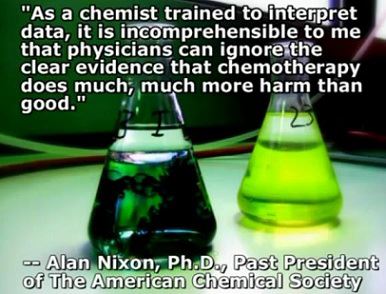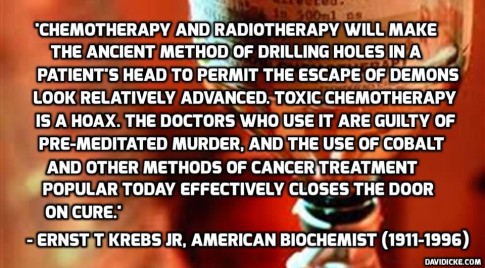Commentary:
The reason why vitamin C infusions are effective in cancer therapy is because of hydrogen peroxide (H202) production, which destroys the cancer causing parasites, sending the ‘immortal’ cancer cells into apoptosis:
– Study: Vitamin C May Fight Cancer (WebMed):
Levine’s team studied vitamin C (also called ascorbate or ascorbic acid) and cancer cells in lab tests. Vitamin C appeared to boost production of hydrogen peroxide, which killed cancer cells and left healthy cells unharmed.
The levels of vitamin C were so high that they could only be achieved through IV infusions.
– Intravenous Vitamin C Kills Cancer Cells:
Recall how hydrogen peroxide is poured on wounds to kill germs. Well now researchers clearly show high-dose vitamin C, when administered intravenously, can increase hydrogen peroxide (H2O2) levels within cancer cells and kills them. I.V. vitamin C was also demonstrated to kill germs and may be an effective therapy for infectious disease.
With a growing body of evidence mounting, National Institutes of Health (NIH) researchers conceded today that intravenous vitamin C may be an effective treatment for cancer. Last year the same researchers reported a similar study but the news media failed to publish it.
The latest study, published in the Proceedings of the National Academy of Sciences, confirms the work of Nobel-Prize winner Dr. Linus Pauling who conducted cancer research in the 1970s with vitamin C. Dr. Pauling’s studies were discredited at the time by poorly conducted research studies at the Mayo Clinic.
Unlike cancer drugs, I.V. vitamin C selectively killed cancer cells, but not healthy cells, and showed no toxicity. The ability of intravenous vitamin C to kill lymphoma cells was remarkable — almost 100% at easily achievable blood serum concentrations.
For inexplicable reasons, NIH researchers continue to maintain high-dose oral vitamin C can produce a limited increase in serum vitamin C concentrations. However, their earlier study published in 2004 clearly showed oral-dose vitamin C can achieve three times greater blood concentration than previously thought possible, a fact which negates the current Recommended Dietary Allowance for vitamin C. [Annals Internal Medicine 140:533—7, 2004] NIH researchers refuse to issue a retraction of their earlier flawed research which mistakenly claimed humans cannot benefit from high-dose oral vitamin C supplements.
The NIH also offered no explanation why it has taken 35 years to confirm the work of Dr. Linus Pauling.
For my German readers:
„Die Ärzte-Zeitung“ berichtete am 14.09.2005 ebenso wie „Spiegel online“ am 13.09.2005 und die „FAZ“ am 18.09.2005 von den Ergebnissen einer amerikanischen Studie des „National Institutes of Health“ in Bethesda/USA : dort wurde an Zellkulturen die krebsabtötende Wirkung von hochdosiertem Vitamin C nachgewiesen. Die Wissenschaftler untersuchten die Wirkung von Ascorbinsäure an zehn Krebszelllinien und vier Kulturen gesunder Körperzellen. Das Ergebnis war eindeutig:
Das Vitamin C tötete gezielt die Krebszellen ab, während die gesunden Zellen nicht geschädigt wurden!
Damit die Tumorzellen tatsächlich abstarben, musste Vitamin C jedoch in sehr hohen Konzentrationen von 8-10g verabreicht werden, wie sie nur durch eine Infusion direkt in die Vene erreicht werden können. Die Ascorbinsäure führt zur Bildung von Wasserstoffperoxid, welches den Tod der Krebszellen verursachte, stellten die Forscher weiter fest. Wasserstoffperoxid entstand dabei jedoch nur in der unmittelbaren Umgebung de Zellen und nicht im Blut. Das Blut sei deshalb ein ideales Transportmittel, mit dem intravenös verabreichte Ascorbinsäure zu den verschiedenen Geweben befördert werden könne, schreiben die Wissenschaftler im Fachblatt „Proceedings of the National Academy of Sciences“ (Bd. 1202, S.13604). Zudem könnte die Ascorbinsäure auch für die Behandlung von Infektionskrankheiten verwendet werden, denn Wasserstoffperoxid spielt im Immunsystem eine wichtige Rolle in der Abwehr von Bakterien und Viren.
Zusammenfassend sind die Ergebnisse der o.g. Studie aus folgenden Gründen wichtig:
- Sie bestätigt Ergebnisse früherer in vitro Studien, dass Vitamin C Tumorzellen zerstören kann.
- Sie zeigt klar, dass Vitamin C diese Wirkung nur in hohen Konzentrationen zeigt, die nur über die parenterale Gabe möglich sind.
- Sie zeigt klar, dass Vitamin C für Tumorzellen toxisch, für normale Zellen aber harmlos ist.
- Sie zeigt, das Vitamin C Tumorzellen durch Herstellung von Wasserstoffperoxid im extrazellulären Raum zerstört.
- Sie zeigt, dass Vitamin C kein Wasserstoffperoxid im Blut generiert.
- Die Autoren schließen daraus, dass die Generierung von Wasserstoffperoxid durch den parenteralen Einsatz von hoch dosiertem Vitamin C auch die Behandlung von Infektionen unterstützt.
Source
This is one of many reasons why the FDA will take injectable vitamin C away from the people.

The FDA has just notified small pharmacies that they will no longer be allowed to manufacture or distribute injectable vitamin C—despite its remarkable power to heal conditions that conventional medicine can’t touch. Please help reverse this outrageous decision!
Let’s get this straight. The government acknowledges the risk of a worldwide flu pandemic. It acknowledges that conventional drugs cannot cure big viruses-like the mononucleosis and hepatitis viruses, many influenza viruses, and many others. It acknowledges that many bacteria have become resistant to antibiotics and are killing increasing thousands. It acknowledges the risk of a worldwide drug-resistant TB pandemic.
Despite acknowledging all this, it now insists on wiping out one of the best potential treatments for these conditions and for certain cancers as well. And why is this being done? What possible rationale is offered? Because it’s dangerous? No. Because it can’t be patented and therefore won’t be taken through the standard FDA approval process. No matter that vitamin C is one of the least toxic components of our food supply and liquid forms of it have been used safely for decades.
By the way, here is what is not safe. Don’t substitute home-made vitamin C solution for pharmaceutical grade liquid. That is not safe for injection. If the FDA action leads someone to do that, the FDA should be held responsible for the results.
The government, instead of banning intravenous vitamin C, should instead be supporting research into it. Even though IV C is being used in burn units around the world, including in the US, and has been adopted by the military for this purpose, the National Institutes of Health (NIH) refuses to fund any studies using intravenous C in patients. There are privately funded studies currently underway, but of course these cannot continue if the FDA bans the substance.
With at least one of the pharmacies, the FDA seems to be banning injectable magnesium chloride and injectable vitamin B-complex 100 as well. These two substances are routinely added to intravenous C to make the “Myers Cocktail,” used especially for conditions such as chronic fatigue syndrome, and infectious diseases such as hepatitis, AIDS, mononucleosis, and flu. The FDA is not going after the Myers Cocktail directly, but is rather attacking each individual substance used to make the cocktail, and may conceivably be going after injectable vitamins and minerals in general, despite such injections being given under the care of a qualified physician.
Please contact the FDA right away, and tell them to stop this foolish war on intravenous vitamin C!
Each of us reading this should think, “Intravenous C could someday save my life.” Dr. Jonathan Collin, editor of the Townsend Letter, discusses the case of a man in New Zealand who nearly died from swine flu. After developing a severe fever and upper respiratory infection, his condition deteriorated and he became comatose. Eventually even a ventilator was insufficient to keep him breathing because his lungs were so compromised by pulmonary edema. After weeks of heroic intervention, doctors decided there was no chance of survival and nothing further should be done for him.
The family asked the hospital to administer intravenous vitamin C. After much disagreement, the hospital gave him 25 grams of vitamin C every 6 hours. There was so much improvement over the next two days that the hospital decided to reinstate his intensive care—but they discontinued the vitamin C, saying that he had improved only because they had rolled him onto his side or his stomach instead of keeping him on his back! Not surprisingly, his condition once again deteriorated.
The family moved him to another facility that reluctantly allowed the IV vitamin C (albeit at a lower dose), and his lung function gradually improved. He came out of coma after four weeks, and after taking vitamin C orally, he gradually improved enough to be discharged. One year later, he was back to flying his plane and surveying his farm in New Zealand. None of the doctors who fought so hard to prevent his treatment with vitamin C have ever acknowledged their error.
Read moreAnd Now: The FDA Is Going After Vitamin C! – ACTION ALERT



